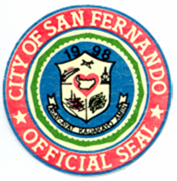Project Background
 Barangay San Francisco is known for its broad expanse of powdery white sand beaches overlooking the South China Sea. A favorite of summer sun and surf worshipers, the area attracts day visitors by the thousands on key weekends and holidays. Many choose to rent one of over 50 beach sheds that are equipped with restrooms and shaded sitting and picnic areas. In an effort to improve sanitation and continue to attract visitors, the San Fernando City Government is engaged in a renovation project that will upgrade the beach sheds, while providing full wastewater treatment facilities that will meet "Class C" discharge requirements as set by the Department of Environment and Natural Resources. The upgraded beach sheds will include sanitary water-sealed toilets, shower facilities, parking space, and a greenbelt planted with native plants in between the parking space and the sheds.
Barangay San Francisco is known for its broad expanse of powdery white sand beaches overlooking the South China Sea. A favorite of summer sun and surf worshipers, the area attracts day visitors by the thousands on key weekends and holidays. Many choose to rent one of over 50 beach sheds that are equipped with restrooms and shaded sitting and picnic areas. In an effort to improve sanitation and continue to attract visitors, the San Fernando City Government is engaged in a renovation project that will upgrade the beach sheds, while providing full wastewater treatment facilities that will meet "Class C" discharge requirements as set by the Department of Environment and Natural Resources. The upgraded beach sheds will include sanitary water-sealed toilets, shower facilities, parking space, and a greenbelt planted with native plants in between the parking space and the sheds.Wastewater Project Elements
The proposed wastewater project will include a sewer collection system, wastewater treatment, disinfection and a disposal system. Each are described below:
Wastewater Collection. The beach sheds occupy a 300 meter stretch of ocean frontage. A boat ramp located near the middle of this stretch is a naturally low lying area, which is chosen for the location of the wastewater treatment plant.
The sewer line will utilize 8" PVC pipeline, which will be adequate to collect and convey the wastewater from each of the beach sheds to the central location for treatment. The pipeline will be laid at a .05% slope and fitted with 4" connection tees so that individual beach sheds may be connected once the renovations are complete.
Two way sewer cleanouts will be installed every 30 meters to facilitate sewer line maintenance. As this is a sanitary sewer system, the introduction of trash and debris will be minimized. Typical operation and maintenance activities, such as sewer line rodding or pressure washing will be required on an annual basis.
Wastewater Treatment System. The heart of the wastewater treatment system will be the EcoTank unit, which is manufactured by Premier Products, Ltd., of Thailand. The EcoTank is an anaerobic treatment tank combined with an anaerobic filter that will produce an effluent of 50 mg/l BOD and TSS, which will meet the Class C requirements of the Deparment of Environment and Natural Resources.
A model EC 60 S treatment tank unit and a model EC 60 AF anaerobic filter unit will comprise the proposed wastewater system. Combined, the system as proposed will be capable of treating 12 cubic meters of wastewater per day, which should be adequate for treating peak flows generated on weekends and holidays. The tanks will allow for a 28 hour detention time, which is required to adequately treat the sewage.
Disinfection of the Treated Effluent. Wastewater effluent from the EcoTank may contain as many as 10,000 fecal coliform units per 100 milliliters of wastewater. Even though there are no limits to fecal coliform discharge to marine waters in the Philippines, due to the popularity of the site, and the potential for contact with effluent, a disinfection system will be provided.
The device pictured at the left is an erosion-style chlorinator. Chlorine in the solid form is commercially available in tablets that can be loaded into feeders that are plumbed in-line with the effluent piping. As the effluent passes through the feed tube and contacts the pellets, a dose of chlorine is imparted to the effluent as the pellets erode.
These devices are easy to maintain and are very effective for low flow systems, such as this San Fernando beach shed project.
Wastewater Disposal. Treated and disinfected wastewater will be recycled and used for planting beds located in the green zone in between the service road and the beach sheds. The reuse system will include an effluent pump, controller and a small diameter piping network that will distribute the effluent evenly throughout the planting beds.
The image shown at the left is a typical effluent lift station. The fiberglass basin serves as the wet well where the treated and disinfected effluent accumulates. When the water level reaches a certain point, the pump is activated and the effluent is sent to the distribution network of pipes. A simple analog controller activates the pump, and also sends a signal should a high water condition exist, indicating a need for maintenance.
The effluent disposal system will also be equipped with a leach trench that will receive treated effluent in the case of overflow. The trench will be located below the beach sheds and designed to filter the treated effluent through sand, which will further increase the clarity of the effluent.
The project will be reviewed by the city engineering and environmental offices, and recommendations made to the City Council and Mayors Office by July, 2010. Should the project be conceptually approved, formal consultations with the barangay officials as well as project partners will begin, as will preparation of the detailed engineering designs and specifications.
Updates to the project will be regularly posted on this website, so please check back often.












